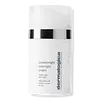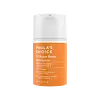What's inside
What's inside
 Key Ingredients
Key Ingredients

 Benefits
Benefits

 Concerns
Concerns

 Ingredients Side-by-side
Ingredients Side-by-side

Water
Skin ConditioningDimethicone
EmollientMethylheptyl Isostearate
Skin ConditioningButylene Glycol
HumectantNiacinamide
Smoothing1,2-Hexanediol
Skin ConditioningCetearyl Ethylhexanoate
EmollientCetyl Alcohol
EmollientIsohexadecane
EmollientCetearyl Alcohol
EmollientGlyceryl Stearate Citrate
EmollientRubus Idaeus Seed Oil
EmollientVaccinium Macrocarpon Seed Oil
Skin ConditioningHexylresorcinol
AntimicrobialLactobacillus/Pumpkin Ferment Extract
Skin ConditioningCananga Odorata Flower Oil
MaskingCitrus Aurantium Dulcis Peel Oil
MaskingCitrus Limon Peel Oil
MaskingPrunus Amygdalus Dulcis Oil
Skin ConditioningJuniperus Mexicana Oil
MaskingRosa Damascena Flower Oil
MaskingHydroxyacetophenone
AntioxidantDipotassium Glycyrrhizate
HumectantLactobacillus Ferment
Skin ConditioningPotassium Cetyl Phosphate
EmulsifyingHydrogenated Phosphatidylcholine
EmulsifyingPhytosterols
Skin ConditioningDimethicone Crosspolymer
Emulsion StabilisingAcrylates/C10-30 Alkyl Acrylate Crosspolymer
Emulsion StabilisingAminomethyl Propanol
BufferingGlyceryl Caprylate
EmollientPolysilicone-11
Tocopherol
AntioxidantTetrasodium Glutamate Diacetate
Zinc Glycinate
BufferingMagnesium Ascorbyl Phosphate
AntioxidantIsostearic Acid
CleansingBenzyl Benzoate
AntimicrobialDecyl Glucoside
CleansingBenzyl Salicylate
PerfumingSodium Hydroxide
BufferingSodium Glycolate
BufferingSodium Formate
BufferingDimethiconol
EmollientLimonene
PerfumingFarnesol
PerfumingWater, Dimethicone, Methylheptyl Isostearate, Butylene Glycol, Niacinamide, 1,2-Hexanediol, Cetearyl Ethylhexanoate, Cetyl Alcohol, Isohexadecane, Cetearyl Alcohol, Glyceryl Stearate Citrate, Rubus Idaeus Seed Oil, Vaccinium Macrocarpon Seed Oil, Hexylresorcinol, Lactobacillus/Pumpkin Ferment Extract, Cananga Odorata Flower Oil, Citrus Aurantium Dulcis Peel Oil, Citrus Limon Peel Oil, Prunus Amygdalus Dulcis Oil, Juniperus Mexicana Oil, Rosa Damascena Flower Oil, Hydroxyacetophenone, Dipotassium Glycyrrhizate, Lactobacillus Ferment, Potassium Cetyl Phosphate, Hydrogenated Phosphatidylcholine, Phytosterols, Dimethicone Crosspolymer, Acrylates/C10-30 Alkyl Acrylate Crosspolymer, Aminomethyl Propanol, Glyceryl Caprylate, Polysilicone-11, Tocopherol, Tetrasodium Glutamate Diacetate, Zinc Glycinate, Magnesium Ascorbyl Phosphate, Isostearic Acid, Benzyl Benzoate, Decyl Glucoside, Benzyl Salicylate, Sodium Hydroxide, Sodium Glycolate, Sodium Formate, Dimethiconol, Limonene, Farnesol
Water
Skin ConditioningDicaprylyl Carbonate
Emollient3-O-Ethyl Ascorbic Acid
Skin ConditioningDimethicone
EmollientButylene Glycol
HumectantPolyglyceryl-6 Distearate
EmulsifyingAscorbyl Glucoside
AntioxidantSqualane
EmollientHydroxyethyl Acrylate/Sodium Acryloyldimethyl Taurate Copolymer
Emulsion StabilisingAcetyl Sh-Hexapeptide-5 Amide Acetate
Skin ConditioningCitrullus Lanatus Seed Oil
EmollientHydrogenated Lecithin
EmulsifyingTheobroma Cacao Seed Butter
EmollientHydrogenated Phosphatidylcholine
EmulsifyingPentaerythrityl Tetra-Di-T-Butyl Hydroxyhydrocinnamate
AntioxidantSodium Hyaluronate
HumectantOryza Sativa Bran Extract
Skin ConditioningPropanediol
SolventJojoba Esters
EmollientTocopherol
AntioxidantAcetyl Zingerone
AntioxidantCetyl Palmitate
EmollientCaprylyl Glycol
EmollientCetyl Alcohol
EmollientPolyglyceryl-3 Beeswax
EmulsifyingSodium Hydroxide
BufferingSorbitan Olivate
EmulsifyingSorbitan Palmitate
EmulsifyingHelianthus Annuus Extract
EmollientEthylhexylglycerin
Skin ConditioningHexylene Glycol
EmulsifyingSodium Phytate
Polysorbate 60
EmulsifyingSorbitan Isostearate
EmulsifyingLecithin
EmollientRosmarinus Officinalis Leaf Extract
AntimicrobialGlycine Soja Oil
EmollientLysolecithin
EmulsifyingBacillus Ferment
Skin ConditioningCitric Acid
BufferingPolyglutamic Acid
Skin ConditioningBeta-Sitosterol
Emulsion StabilisingPhytic Acid
Squalene
EmollientPhenoxyethanol
PreservativeSodium Benzoate
MaskingPotassium Sorbate
PreservativeWater, Dicaprylyl Carbonate, 3-O-Ethyl Ascorbic Acid, Dimethicone, Butylene Glycol, Polyglyceryl-6 Distearate, Ascorbyl Glucoside, Squalane, Hydroxyethyl Acrylate/Sodium Acryloyldimethyl Taurate Copolymer, Acetyl Sh-Hexapeptide-5 Amide Acetate, Citrullus Lanatus Seed Oil, Hydrogenated Lecithin, Theobroma Cacao Seed Butter, Hydrogenated Phosphatidylcholine, Pentaerythrityl Tetra-Di-T-Butyl Hydroxyhydrocinnamate, Sodium Hyaluronate, Oryza Sativa Bran Extract, Propanediol, Jojoba Esters, Tocopherol, Acetyl Zingerone, Cetyl Palmitate, Caprylyl Glycol, Cetyl Alcohol, Polyglyceryl-3 Beeswax, Sodium Hydroxide, Sorbitan Olivate, Sorbitan Palmitate, Helianthus Annuus Extract, Ethylhexylglycerin, Hexylene Glycol, Sodium Phytate, Polysorbate 60, Sorbitan Isostearate, Lecithin, Rosmarinus Officinalis Leaf Extract, Glycine Soja Oil, Lysolecithin, Bacillus Ferment, Citric Acid, Polyglutamic Acid, Beta-Sitosterol, Phytic Acid, Squalene, Phenoxyethanol, Sodium Benzoate, Potassium Sorbate
 Reviews
Reviews

Alternatives
Ingredients Explained
These ingredients are found in both products.
Ingredients higher up in an ingredient list are typically present in a larger amount.
Butylene Glycol (or BG) is used within cosmetic products for a few different reasons:
Overall, Butylene Glycol is a safe and well-rounded ingredient that works well with other ingredients.
Though this ingredient works well with most skin types, some people with sensitive skin may experience a reaction such as allergic rashes, closed comedones, or itchiness.
Learn more about Butylene GlycolCetyl Alcohol is a fatty alcohol. Fatty Alcohols are most often used as an emollient or to thicken a product.
Its main roles are:
Though it has "alcohol" in the name, it is not related to denatured alcohol or ethyl alcohol.
The FDA allows products labeled "alcohol-free" to have fatty alcohols.
Learn more about Cetyl AlcoholDimethicone is a type of synthetic silicone created from natural materials such as quartz.
What it does:
Dimethicone comes in different viscosities:
Depending on the viscosity, dimethicone has different properties.
Ingredients lists don't always show which type is used, so we recommend reaching out to the brand if you have questions about the viscosity.
This ingredient is unlikely to cause irritation because it does not get absorbed into skin. However, people with silicone allergies should be careful about using this ingredient.
Note: Dimethicone may contribute to pilling. This is because it is not oil or water soluble, so pilling may occur when layered with products. When mixed with heavy oils in a formula, the outcome is also quite greasy.
Learn more about DimethiconeWe don't have a description for Hydrogenated Phosphatidylcholine yet.
Sodium Hydroxide is also known as lye or caustic soda. It is used to adjust the pH of products; many ingredients require a specific pH to be effective.
In small amounts, sodium hydroxide is considered safe to use. However, large amounts may cause chemical burns due to its high alkaline.
Your skin has a natural pH and acid mantle. This acid mantle helps prevent harmful bacteria from breaking through. The acid mantle also helps keep your skin hydrated.
"Alkaline" refers to a high pH level. A low pH level would be considered acidic.
Learn more about Sodium HydroxideTocopherol (also known as Vitamin E) is a common antioxidant used to help protect the skin from free-radicals and strengthen the skin barrier. It's also fat soluble - this means our skin is great at absorbing it.
Vitamin E also helps keep your natural skin lipids healthy. Your lipid skin barrier naturally consists of lipids, ceramides, and fatty acids. Vitamin E offers extra protection for your skin’s lipid barrier, keeping your skin healthy and nourished.
Another benefit is a bit of UV protection. Vitamin E helps reduce the damage caused by UVB rays. (It should not replace your sunscreen). Combining it with Vitamin C can decrease sunburned cells and hyperpigmentation after UV exposure.
You might have noticed Vitamin E + C often paired together. This is because it is great at stabilizing Vitamin C. Using the two together helps increase the effectiveness of both ingredients.
There are often claims that Vitamin E can reduce/prevent scarring, but these claims haven't been confirmed by scientific research.
Learn more about TocopherolWater. It's the most common cosmetic ingredient of all. You'll usually see it at the top of ingredient lists, meaning that it makes up the largest part of the product.
So why is it so popular? Water most often acts as a solvent - this means that it helps dissolve other ingredients into the formulation.
You'll also recognize water as that liquid we all need to stay alive. If you see this, drink a glass of water. Stay hydrated!
Learn more about Water